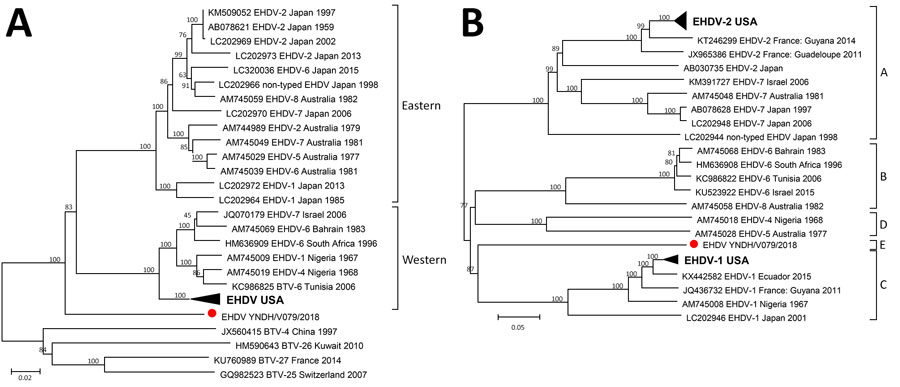Volume 26, Number 12—December 2020
Research Letter
Novel Serotype of Epizootic Hemorrhagic Disease Virus, China
Figure

Figure. Phylogenetic analyses of EHDV based on segment 3 (A) and segment 2 (B) of YNDH/V079/2018 from Mangshi County, Yunnan Province, China (red dot), compared with other global EHDV isolates. The following convention was used to identify sequences: GenBank accession no., EHDV-serotype, country, isolation year. Eastern and Western topotypes of segment 3 and A−D groups of segment 2 were assigned as described by Anthony et al. (2,10); a distinct segment 2 group of the strain YNDH/V079/2018 isolated in China (2) is marked as group E. The nontyped strain from Japan isolated in 1998 is included in accession nos. LC202966 and LC202944 (4). We did not include the nontyped strain from South Africa, due to the lack of sequence information in GenBank. BTV strains were used as the outgroups. Number at each branch indicates a bootstrap value. Scale bars indicate nucleotide substitutions per site. BTV, bluetongue virus; EHDV, epizootic hemorrhagic disease virus.
References
- World Organisation for Animal Health. Epizootic hemorrhagic disease (infection with epizootic hamorrhagic disease virus). In: Manual of diagnostic tests and vaccines for terrestrial animals 2019. Paris; The Organisation: 2018. p. 422–32.
- Anthony SJ, Maan S, Maan N, Kgosana L, Bachanek-Bankowska K, Batten C, et al. Genetic and phylogenetic analysis of the outer-coat proteins VP2 and VP5 of epizootic haemorrhagic disease virus (EHDV): comparison of genetic and serological data to characterise the EHDV serogroup. Virus Res. 2009;145:200–10. DOIPubMedGoogle Scholar
- Maan NS, Maan S, Potgieter AC, Wright IM, Belaganahalli M, Mertens PPC. Development of real-time RT-PCR assays for detection and typing of epizootic haemorrhagic disease virus. Transbound Emerg Dis. 2017;64:1120–32. DOIPubMedGoogle Scholar
- Shirafuji H, Kato T, Yamakawa M, Tanaka T, Minemori Y, Yanase T. Characterization of genome segments 2, 3 and 6 of epizootic hemorrhagic disease virus strains isolated in Japan in 1985-2013: Identification of their serotypes and geographical genetic types. Infect Genet Evol. 2017;53:38–46. DOIPubMedGoogle Scholar
- Golender N, Bumbarov VY. Detection of epizootic hemorrhagic disease virus serotype 1, Israel. Emerg Infect Dis. 2019;25:825–7. DOIPubMedGoogle Scholar
- Temizel EM, Yesilbag K, Batten C, Senturk S, Maan NS, Mertens PPC, et al. Epizootic hemorrhagic disease in cattle, Western Turkey. Emerg Infect Dis. 2009;15:317–9. DOIPubMedGoogle Scholar
- Kamomae Y, Kamomae M, Ohta Y, Nabe M, Kagawa Y, Ogura Y, et al. Epizootic hemorrhagic disease virus serotype 6 infection in cattle, Japan, 2015. Emerg Infect Dis. 2018;24:902–5. DOIPubMedGoogle Scholar
- Maan NS, Maan S, Nomikou K, Johnson DJ, El Harrak M, Madani H, et al. RT-PCR assays for seven serotypes of epizootic haemorrhagic disease virus & their use to type strains from the Mediterranean region and North America. PLoS One. 2010;5:
e12782 . DOIPubMedGoogle Scholar - Maan S, Rao S, Maan NS, Anthony SJ, Attoui H, Samuel AR, et al. Rapid cDNA synthesis and sequencing techniques for the genetic study of bluetongue and other dsRNA viruses. J Virol Methods. 2007;143:132–9. DOIPubMedGoogle Scholar
- Anthony SJ, Maan N, Maan S, Sutton G, Attoui H, Mertens PP. Genetic and phylogenetic analysis of the core proteins VP1, VP3, VP4, VP6 and VP7 of epizootic haemorrhagic disease virus (EHDV). Virus Res. 2009;145:187–99. DOIPubMedGoogle Scholar
1These authors contributed equally to this article.